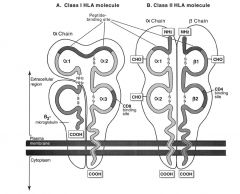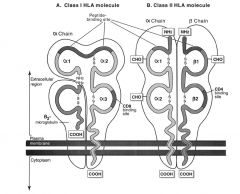![]()
![]()
![]()
Use LEFT and RIGHT arrow keys to navigate between flashcards;
Use UP and DOWN arrow keys to flip the card;
H to show hint;
A reads text to speech;
11 Cards in this Set
- Front
- Back
|
What is MHC restriction? What is meant by altered self?
|
The MHC selects a number of peptides to be presented and this limited set of peptides and the way they are recognized by T cells is called MHC restriction. Since the peptide that binds the MHC molecule will change the way the immune system perceives these molecules, one can say that the immune system recognizes "altered self" (ie. it is a "self molecule" (MHC) that has been changed by the addition of a "foreign" peptide)
|
|
|
Describe the structure of the MHC class I molecule
|

MHC class I consists of:
♦α-chain is variable from one individual to the other and selects the peptides to be presented. The α-chain forms the "BBQ with the 2 sausages" that captures the peptides to be presented ♦β2-microglobulin is constant amongst individuals and does not interact with the antigenic peptide that is presented |
|
|
Describe the structure of the MHC class II molecule
|

MHC class II is found on antigen presenting cells which include macrophages, dendritic cells, B cells, and in some species (humans, and ruminants but not mice) also on activated T cells
MHC class II consists of: ♦α-chain is variable from one individual to the other and selects the peptides to be presented. The α-chain and the β-chain together form the "BBQ with the 2 sausages" that captures the peptides to be presented ♦β-chain is also variable from one individual to the other and selects the peptides to be presented; The α-chain and the β-chain together form the "BBQ with the 2 sausages" that captures the peptides to be presented |
|
|
What is MHC polymorphism?
|
Refers to the expression of MHC molecules by different individuals of the same species. For MHC genes the polymorphism is so high that for all practical purpose all individuals will have different MHC molecules. (ie. it is extremely unlikely that unrelated individuals would be chance to have the same MHC, obviously identical twins, inbred animals and animals born following embryo split, have the same MHC)
|
|
|
What is an MHC haplotype?
|
The combination of MHC genes present on a particular chromosome.
|
|
|
How many different alleles are there for MHC class one and how many combinations are possible?
|
There are 3 polymorphic MHC class I α-chain gene alleles in each individual and since each individual inherits a different set from each parent, each individual expressed 6 different MHC I α-chain molecules. Because there is only one β-chain, which has to combine with an α-chain, there are a total of 6 different MHC I molecules on the surface of most nucleated cells of each individual
|
|
|
How many different alleles are there for MHC class II and how many combinations are possible?
|
There are 4 polmorphic class II gene alleles (both for the α-chains and the β-chains) in each individual. However, each of the α-chains can associated with several β-chains so that a high degree of diversity can be created. Not all combinations have the same assembly efficiency and in practice the number of different class II MHC molecules expressed on APC is variable between individuals
|
|
|
In what fashion are MHC molecules expressed?
|
Expressed in a co-dominant fashion, meaning that one individual will express MHC molecules inherited from both the father and mother simultaneously
|
|
|
Are MHC alleles distributed randomly in populations?
|
No, since certain MHC haplotypes will gain an advantage when a particular disease is prevalent in an area
|
|
|
Why is MHC polymorphism so important?
|
INDIVIDUAL LEVEL:
Because the MHC selects the peptides that are presented from each pathogen the particular MHC expressed by an individual will play a major role in determining how effective the immune response to that pathogen is going to be. Thus some individuals will be better at mounting immune responses to particular pathogens than others. The diversity between MHC molecules is in the barbeque region and thus around the area responsible for selecting peptides to be presented to the T cells. Certain MHC haplotypes are more at risk than other for autoimmune disease. POPULATION LEVEL: MHC polymorphism helps protect the population against eradication from a particular dangerous disease by allowing certain individuals to survive the disaster by having a MHC that is good at combating the disease. The reverse is true too, ie. if the population is genetically homogenous, a single disease can wipe out the entire population ie. inbred animals such as chickens |
|
|
What is host-versus-graft response and what is graft vs. host response?
|
When tissues from one individual are grafted to the other, the MHC of the grafted tissue is in all likelihood (unless identical twins, inbred animals or embryo splits) going to be different from the MHC on the host. The host will recognize this difference in MHC molecule and reject the graft. This response is called host-vs-graft response
Similarly, the immune cells in the graft will also recognize the MHC molecules of the host tissue and reject the hose in a response referred to s a graft-versus-host response. |

